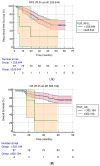Changes in Inflammatory Markers Predict the Prognosis of Resected Hepatocellular Carcinoma with Child-Pugh A
- PMID: 36005195
- PMCID: PMC9406633
- DOI: 10.3390/curroncol29080457
Changes in Inflammatory Markers Predict the Prognosis of Resected Hepatocellular Carcinoma with Child-Pugh A
Abstract
(1) Background: The reasons for changes in the inflammatory markers of patients with surgically resected hepatocellular carcinoma are unclear. We aimed to investigate the association of an inflammatory status with the prognosis of patients with hepatocellular carcinoma, who underwent surgical resection. (2) Methods: We retrospectively enrolled 91 patients with Child A hepatocellular carcinoma, who had received surgical resection, to explore the influence of preoperative inflammatory markers and postoperative changes on the prognosis. (3) Results: The platelet-to-lymphocyte ratio (PLR) and its alteration were independent prognostic factors. Patients with a low PLR had a significantly better recurrence-free survival (RFS) than those with a high PLR (1-year RFS of 88.5% versus 50.0%; 3-year RFS of 62.1% versus 25.0%, p = 0.038). The patients with a low PLR showed a significantly better overall survival (OS) than those with a high PLR (1-year OS of 98.9% versus 75.0%; 3-year OS of 78.2% versus 25.0%, p = 0.005). The patients whose PLR had increased at 6 months after operation showed a worse OS than patients whose PLR had decreased (1-year OS of 96.3% versus 98.4%; 3-year OS of 63.0% versus 79.7%, p = 0.048). However, neither the neutrophil-to-lymphocyte ratio nor Onodera's prognostic nutritional index had any prognostic significance. (4) Conclusions: The PLR and its alteration are significant prognostic factors for the RFS and OS of patients with Child A hepatocellular carcinoma who had received curative surgery.
Keywords: hepatocellular carcinoma; inflammatory markers; prognosis.
Conflict of interest statement
The authors declare no conflict of interest.
Figures


Similar articles
-
Model for end-stage liver disease-dependent prognostic capacity of platelet-to-lymphocyte ratio following liver transplantation for hepatocellular carcinoma.Transpl Immunol. 2024 Aug;85:102071. doi: 10.1016/j.trim.2024.102071. Epub 2024 Jun 10. Transpl Immunol. 2024. PMID: 38866187
-
Preoperative inflammatory markers as prognostic predictors after hepatocellular carcinoma resection: data from a western referral center.BMC Surg. 2022 Sep 2;22(1):329. doi: 10.1186/s12893-022-01779-6. BMC Surg. 2022. PMID: 36056350 Free PMC article.
-
Prognostic significance of preoperative aspartate aminotransferase to neutrophil ratio index in patients with hepatocellular carcinoma after hepatic resection.Oncotarget. 2016 Nov 1;7(44):72276-72289. doi: 10.18632/oncotarget.10848. Oncotarget. 2016. PMID: 27472390 Free PMC article.
-
Significance of neutrophil-to-lymphocyte ratio, platelet-to-lymphocyte ratio and prognostic nutrition index as preoperative predictors of early mortality after liver resection for huge (≥10 cm) hepatocellular carcinoma.J Surg Oncol. 2016 May;113(6):621-7. doi: 10.1002/jso.24197. Epub 2016 Feb 10. J Surg Oncol. 2016. PMID: 26861568
-
Prognostic value of preoperative lymphocyte-related systemic inflammatory biomarkers in upper tract urothelial carcinoma patients treated with radical nephroureterectomy: a systematic review and meta-analysis.World J Surg Oncol. 2020 Oct 23;18(1):273. doi: 10.1186/s12957-020-02048-7. World J Surg Oncol. 2020. PMID: 33097052 Free PMC article.
Cited by
-
Assessment of the Clinical Value of Platelet-to-Lymphocyte Ratio in Patients with Hepatocellular Carcinoma.Clin Appl Thromb Hemost. 2024 Jan-Dec;30:10760296231221535. doi: 10.1177/10760296231221535. Clin Appl Thromb Hemost. 2024. PMID: 38591958 Free PMC article.
-
Prognostic value of neutrophil-to-lymphocyte ratio in patients with hepatocellular carcinoma receiving curative therapies: a systematic review and meta-analysis.BMC Cancer. 2025 Mar 29;25(1):571. doi: 10.1186/s12885-025-13972-w. BMC Cancer. 2025. PMID: 40158082 Free PMC article.
-
Concordance Index-Based Comparison of Inflammatory and Classical Prognostic Markers in Untreated Hepatocellular Carcinoma.J Clin Med. 2025 Aug 5;14(15):5514. doi: 10.3390/jcm14155514. J Clin Med. 2025. PMID: 40807132 Free PMC article.
References
MeSH terms
Substances
LinkOut - more resources
Full Text Sources
Medical

